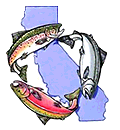The Trinity River- A Living Laboratory for Salmonid Habitat Restoration
29 April 2026
Field Tour Coordinators: James Lee, TRRP Implementation Branch Chief, Eric Peterson, TRRP Science Coordinator, with assistance from Mike Dixon, TRRP Executive Director
The Trinity River and its abundant runs of Chinook, coho, and steelhead sustained unique cultures of Native Americans for millennia and continue to provide a large portion of the anadromous fish populations in the Klamath basin. Yet since the 1960’s, this river is also a critical component of California’s water infrastructure, with approximately half of its annual flow diverted out-of-basin for energy production, irrigation, and municipal purposes. In the landscape context of an area that was heavily exploited by mining and timber extraction, this diversion led to unanticipated changes to the physical form of the river itself, which was detrimental to native fish populations. The Trinity River Restoration Program (TRRP)- a multi-agency program represented by eight county, tribal, and federal agencies with an interest in improving the fishery-was formed to address the gap caused by the use of the river and its resulting consequences.
Among the tools that TRRP uses is channel rehabilitation- physically changing the shape of the channel and floodplain to support the attributes necessary to sustain anadromous fish populations at ecologically, culturally, and economically meaningful levels. Channel rehabilitation projects are intended to interact with managed flows and the sediment supply to not only provide short-term habitat benefits, but also to continue to evolve into the future in ways that maintain these benefits.
Several recent projects that incorporate not only lessons learned over decades of restoration within the Trinity River, but also lessons learned from other rivers and practitioners, provide examples of how and why TRRP restores ecological function through restoring the form of the Trinity River.
The tour will depart Redding in the morning, and travel directly to Junction City, CA where several sites of varying ages are readily available for field-based presentations and up-close inspections of some of the work that TRRP has performed. Some projects that will be observed include the Oregon Gulch, Chapman Ranch, and Upper Conner Creek projects. You will see some of the most significant projects TRRP has implemented, as well as budding riparian vegetation, riparian birds establishing nesting territories, and (water clarity permitting) juvenile salmonids foraging and sheltering in the shallows. After a wonderful day in the field we will return to Redding in the evening. Be prepared to get your feet wet and potentially be rained on, and bring plenty of water to drink.
